|
| |
Archives
give us this day our daily photograph

Sidewalk Closed
bigger
gordy's image archive index
Efke 25 in the Salut-S.
iraq
Analysis: The many faces of Iraq's war
|
There is no longer one war raging in Iraq. There are now at least three different, though overlapping ones, and very soon their number could rise to four.
The first war, of course, is the already nearly three-year-old Sunni Muslim insurrection against both U.S. forces and the democratically elected Iraqi government in Baghdad. This is the war that understandably has preoccupied the American public, Congress and Bush administration policymakers.
But since the Feb. 22 bombing of the al-Askariya, or Golden Mosque, in Samara, the Sunni insurgents have succeed in provoking a massive and far-ranging grassroots Shiite reaction against them. This has been flaring on a far vaster scale on both sides than the Sunni insurgents -- originally led by a combination of former Saddam Hussein Baath party loyalists and al-Qaida extreme Islamists -- wanted to achieve.
And in the north, largely overlooked, the Kurds supported and protected by U.S. power, have been forcibly exerted their own control over resentful Assyrian and Turkoman minority communities. The Kurd-Turkoman conflict, almost totally ignored in the U.S. media, is particularly significant because Turkey, a key U.S. ally and NATO member and traditionally hostile to Kurdish independence, feels strong ethnic loyalty to the Turkomans from the days of the old Ottoman Empire.
As Chaim Kaufmann wrote in the New York Jewish newspaper the Forward Friday, "Not one but two full-scale communal conflicts are raging in Iraq. In the north of the country, the Kurds are fighting several other communities for the oil-rich Kirkuk Province. Further south, Sunnis and Shiites are struggling for control of a roughly 100-mile-deep band of mixed settlement that runs across central Iraq, including Baghdad."
And there is a fourth potential war that would likely prove the most bloody and devastating of all. That would explode if the Shiite militias of southern and central Iraq rose up against U.S. and British forces in the region and sought to deny the U.S armed forces its vital land supply artery from Kuwait up to Baghdad.
| |
[more]
thanks to Antiwar.com
Civilians in Iraq Flee Mixed Areas as Attacks Shift
|
The war in Iraq has entered a bloodier phase, with the killings of Iraqi civilians rising tremendously in daily sectarian violence while American casualties have steadily declined, spurring tens of thousands of Iraqis to flee from mixed Shiite-Sunni areas.
The new pattern, detailed in casualty and migration statistics from the past six months and in interviews with American commanders and Iraqi officials, has led to further separation of Shiite and Sunni Arabs, moving the country toward a de facto partitioning along sectarian and ethnic lines — an outcome that the Bush administration has doggedly worked to avoid over the past three years.
| |
[more]
The collapse of the Iraqi Army
Disintegration of Iraq would pose multiple problems for Israel
thanks to Juan Cole
Rice tries to sell the unsellable
How Massacres Become the Norm
IR Warrior
Tomgram: Noam Chomsky on War Crimes in Iraq
Cannon fodder at State
The U.S. is sending diplomats into Iraq, but refusing to give them military protection. No wonder Foreign Service morale is collapsing.
photography
A ruins photoblog.
WORKSONGS
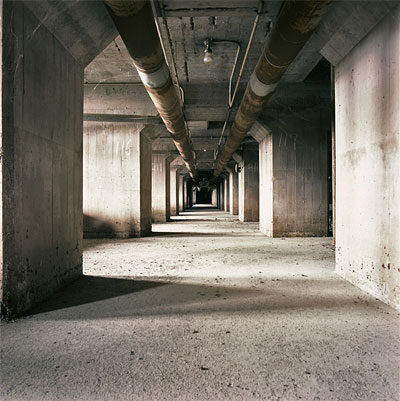
[more]
thanks to orbit1.com
iran
US War Planners Should Listen to Israel Regarding Iran
|
As I stated on Christopher Lydon's NPR show, Radio Open Source, tonight -- one of the take-aways from my recent Israel trip is that Israeli national security bureaucrats -- diplomats and generals -- have far greater confidence that there are numerous potential solutions to the growing Iran crisis short of bombing them in an invasive, hot attack.
One of the issues that came up in many of the national security related discussions I had was that Israel has maintained and cultivated a very strong human intelligence network inside Iran. The two nations were close strategic allies 25 years ago -- and continue, in many behind-the-scenes ways, to communicate and possibly even to coordinate certain actions. It doesn't mean that Israel is ready to appease Iran's regional ambitions, but it does mean that I have witnessed far more worries about Iranian President Ahmadinejad's anti-Holocaust and anti-Israel rhetoric in the U.S. than I did in Tel Aviv or Jerusalem.
| |
[more]
thanks to Talking Points Memo
restrooms
Men’s restroom mural
|
“Edge Designs is an all women run company that designs interior office space. They had a recent opportunity to do an office project in NYC. The client allowed the women of this company a free hand in all design aspects. The client was a company that was also run by all women execs…. The result….”
| |

[more]
thanks to Politics in the Zeros
And here is a larger view.
bipartisan war profiteering
The Palazzo Feinstein
The Mansion the War Bought
|
It happens all the time. If the antiwar movement takes on the Democrats for their bitter shortcomings a few liberals are bound to criticize us for not hounding Bush instead. It doesn't even have to be an election year to get the progressives fired up. They just don't seem to get it. "How can you attack the Democrats when we have such a bullet-proof administration ruling the roost in Washington," somebody recently emailed me, "Don't you have something better to do than write this trash?!"
Well, not really. It's too cold in upstate New York right now to do anything other than fume over the liberal villains in Washington. "Why do I write about the putrid Democratic Party?" I responded, "I'll tell you, there's a reason this Republican administration is so damn bullet proof -- nobody from the opposition party is taking aim and pulling the trigger."
And that's why the Dems are just as culpable in all that has transpired since Bush took office in 2000. They aren't just a part of the problem -- the Democrats are the problem.
| |
[more]
thanks to Yolanda Flanagan
book recommendation

Hokusai
by by Matthi Forrer
This is a reasonably priced introduction to one of the greatest wood block printers in Japan. Not much on text but long on prints. And what amazing prints they are. Hokusai lived from 1760-1849, at the end of Japan's self-imposed isolation. Even though contact with the outer world was minimal, Hokusai was aware of Western art and was influenced by it. An influence that was returned as, when Japan was opened in the latter half of the 19th century, Western artists were influenced by Japan's wood block prints. It boggles the mind to look at the fine detail on these prints and realize that these were printed from multiple wood blocks in which the images were carved. Aside from the exquisite coloring and composition, they are also views of life in feudal Japan.
oil
The Strip Mining Century:
American Thermidor On Steroids
|
The essential thesis of American Thermidor is that America has become caught in an economic vicious circle - we import energy from places that do not import anything from us other military fiat and financial services - they, in turn, recycle the money we send them back here, corrupting our political system, but also distorting our economy. In response, we take steps which concentrate wealth. This creates a deficit of jobs, which gives people even more of an incentive to cut taxes and investment, and instead speculate on land. To do this requires burning more energy than we otherwise would, which, in turn makes our energy deficit worse, starting the cycle all over again.
People have asked me what we should do. Well, until someone raids the oil for land casino, there really isn't very much we can do. However, there are things we can do that will make it much worse. Yergin's very poorly thought out - or enormously self-serving, I am not sure which - article in today's Times of London reminds me of what "worse" looks like.
The Strip Mining Century.
The Strip Mining Century is the Windows of Energy policy - backwards compatibility to keep the billionaires in place and the personal capital working - at all cost. At any cost. At every cost.
Windows is running late, runs slow, and has enormous and constant security issues. That, in a nutshell, is the strip mining century.
But what is it? The strip mining century sees the capital in existence, and asks "what do we need to do to keep it working?" Yergin outlines it fairly well: drop a ton of money into new refineries, accept crummy LCA petroleum sources that require strip mining, make the poor pay out every available orifice for the whole thing - and spew gigatons of carbon into the air.
| |
[more]
thanks to The Agonist
Growth
by Jim Kunstler
|
Americans ought to regard the word "growth" with trepidation. When invoked by presidents and economists, it is meant to imply ideas like "more" or "better." It's a habit of thinking left over from the exuberant phase of the industrial age, when there was always more of everything to get. Nowadays, though, as we enter terminal years of cheap energy, the word "growth" invokes a new set ideas.
For instance, "impossible." With the price of oil edging toward $70-a-barrel now, and likely to flirt with $100 by the end of the year, the effect will be higher costs for virtually all products and services, and tremendous stress on every socioeconomic organism from the family to government at all levels to the Ford Motor Car Corporation. The only "growth" we might expect under these conditions is the growth in our exertions to stay where we are, and the truth is that many of the weak will simply fall behind.
| |
[more]
movie recommendation

The Tao of Steve
I like different little movies. Refreshing and fun. Catalogued under comedy, drama and romance. From Amazon:
|
Plot Synopsis: In his early 30s, the beer-bellied Dex has things figured out. He's widely read in philosophy, he's studied Steve McQueen the prototypical cool American hero, and he's distilled Buddhism and Taoism into three laws that make him a hit with women: don't express desire, do something heroic in front of her, then retreat. A part-time job with young children, beer, guys, Frisbee golf, pool, poker, his dog Astro, and sex: what could be missing? Then, at his ten-year college reunion, Dex meets Syd, and the "Tao of Steve" may not be enough to get him what he wants. Plus, Syd remembers something important that Dex has forgotten. Can a cool smart guy, 50 pounds overweight, find his bliss?
| |
plamegate
Murry Waas writes a major piece about the Valerie Plame affair and then there are links to three pieces about the Murray Waas piece.
Insulating Bush
By Murray Waas
|
Karl Rove, President Bush's chief political adviser, cautioned other White House aides in the summer of 2003 that Bush's 2004 re-election prospects would be severely damaged if it was publicly disclosed that he had been personally warned that a key rationale for going to war had been challenged within the administration. Rove expressed his concerns shortly after an informal review of classified government records by then-Deputy National Security Adviser Stephen J. Hadley determined that Bush had been specifically advised that claims he later made in his 2003 State of the Union address -- that Iraq was procuring high-strength aluminum tubes to build a nuclear weapon -- might not be true, according to government records and interviews.
| |
[more]
Motive, Meet Your Cohorts Opportunity and Intent…
Waas on Plamegate
The Plame Game
What Murray Waas’s big scoop may really tell us about Bush’s pre-war deceptions.
Then today it comes out that Bush authorized the leak. Hmmmm.
BIG BUSH NEWS: Does the President Plan to Fire Himself?
photography
Phil webber: 50 years of Photos
|
Phil H. Webber died on March 18, 2006. This is a retrospective of his work during five decades as a P-I photographer.
| |

[more]
nuclear madness
Privatizing the Apocalypse
|
Started as the super-secret "Project Y" in 1943, the Los Alamos National Laboratory in New Mexico has long been the keystone institution of the American nuclear-weapons producing complex. It was the birthplace of Fat Man and Little Boy, the two nuclear bombs the U.S. dropped on Hiroshima and Nagasaki in August 1945. Last year, the University of California, which has managed the lab since its inception, was supplanted when the Department of Energy decided to put Los Alamos on the auction block. In December 2005, construction giant Bechtel won a $553 million seven-year management contract to run the sprawling complex, which employs more than 13,000 people and has an estimated $2.2 billion annual budget.
"Privatization" has been in the news ever since George W. Bush became president. His administration has radically reduced the size of government, turning over to private companies critical governmental functions involving prisons, schools, water, welfare, Medicare, and utilities as well as war-fighting, and is always pushing for more of the same. Outside of Washington, the pitfalls of privatization are on permanent display in Iraq, where companies like Halliburton have reaped billions in contracts. Performing jobs once carried out by members of the military -- from base building and mail delivery to food service -- they have bilked the government while undermining the safety of American forces by providing substandard services and products. Halliburton has been joined by a cottage industry of military-support companies responsible for everything from transportation to interrogation. On the war front, private companies are ubiquitous, increasingly indispensable, and largely unregulated -- a lethal combination.
Now, the long arm of privatization is reaching deep into an almost unimaginable place at the heart of the national security apparatus --- the laboratory where scientists learned to harness the power of the atom more than 60 years ago and created weapons of apocalyptic proportions.
| |
[more]
that was the week that was
A busy week with not much time for posting. We visited Zoe's mom, Gerry, today. I think this is the best I've seen her since she moved to the care facility for her Alzheimers. As soon as she saw us she started to wave her arms in the air to catch our attention and had a big smile on her face. She definitely still recognizes us. She still can't talk well and she sat the entire time we were with her so I don't know how she is doing physically but part of her is still in there and it was good visiting with her.
Camera strap business is up and so is shooting. My pano test failed. Somehow I didn't allow for overlap so the stitching software would work. A definite brain fade. I should be getting three rolls of 120 roll film back from Panda Lab tomorrow. One is my first roll of black and white Efke 25 shot in the Salut-S. I'm very interested in how this almost grainless film comes out. There is a roll of Ilford FP4 shot with the Salut-S. It's a black and white ISO 125 film. It has a couple of hand held panos on it, with lots of overlap. And a roll of Ilford Delta 3200, shot with the Mamiya Universal with a combination of pinhole and 65mm (28 mm equiv.)
There was a thread at Rangefinder Forum this week on the Zorki I. I've having more appreciation of the Leica II, early Leica IIIs, and the Zorki 1. Similar to my Leica IIIc but even smaller. A perfect body for my collapsible Industar-50. In the end I decided to use the Industar-50 on my Leica IIIc. The IIIc has a diopter adjustment for my aging eyes and it has slow speeds. That and I already own a IIIc.
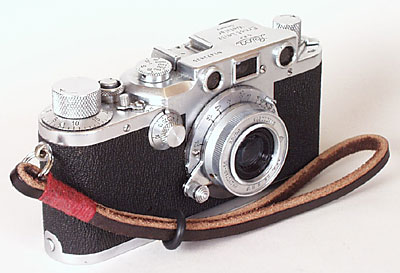
The lens collapses for carrying around. The little Leica, with the non-collapsible J8, will fit in my side coat pocket. With the little I-50 it fits in the inside chest pocket in my coat.
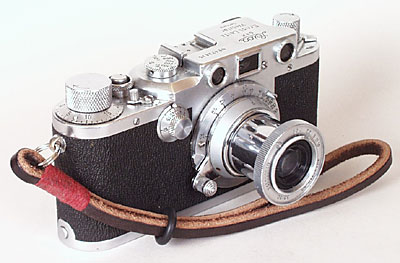
It pulls out and locks for use.
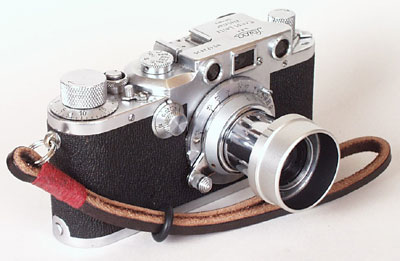
The cute little lens hood is an A36 from CameraQuest but they don't seem to have them anymore. It's great for when I want to carry around one camera on a daily basis.
My potato bonsai project has started. I bought the potato tonight. Pictures, many pictures, will ensue. Be afraid.
give us this day our daily photograph

Katie, Evan, and Jenny
bigger
gordy's image archive index
One of the black and white rolls taken last summer. Two daughters and a grandson.
give us this day our daily photograph
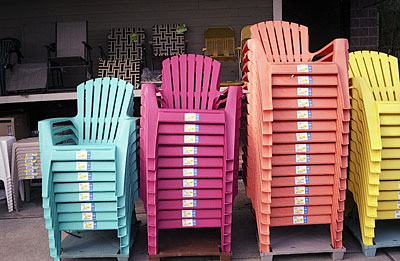
Spring Chairs
bigger
gordy's image archive index
The last of the Pass the Camera pictures. The outdoor chairs on sale at the local Ace Hardware. Spring is here. I should be back with links tomorrow. The panos will have to wait. I screwed up on the calibration of the pano head and I ended up with no overlap. If I had actually looked throught the viewfinder I would have known. Cue sound of head banging against wall. Time to recalibrate the pano head and shoot again.
give us this day our daily photograph
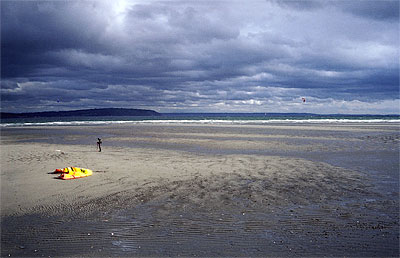
Parasurfing at Double Bluff
bigger
gordy's image archive index
It was cold! This is the fifth of six Pass the Camera Photographs. I have a couple of panos back from the lab that I haven't scanned yet. In the next couple of days. Shot some more panos the weekend. A vertical and a horizontal mosaic which really isn't a pano but kind of. They get sent off to the lab tomorrow.
|
|
|
|













